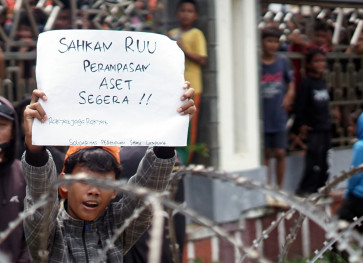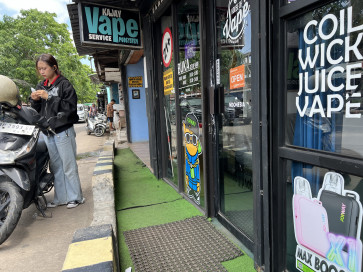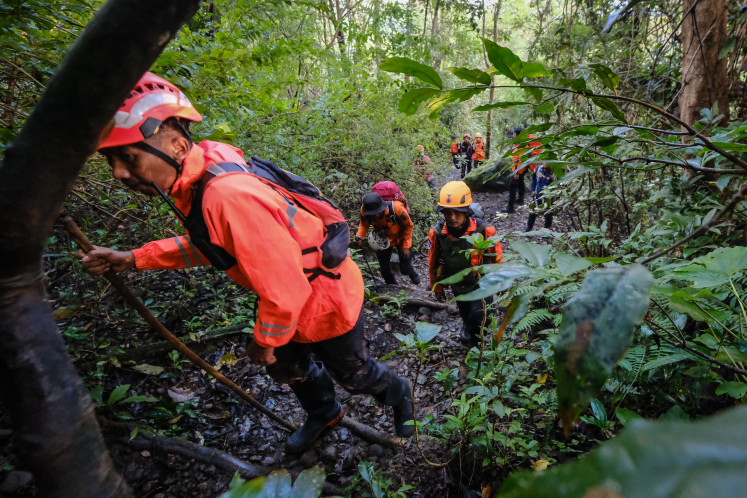Popular Reads
Top Results
Can't find what you're looking for?
View all search resultsPopular Reads
Top Results
Can't find what you're looking for?
View all search resultsSamuel Indratma, WRITING ON THE WALLS
JP/Slamet Susanto Years ago, the Lempuyangan station walkway was covered in pornographic and racist graffiti
Change text size
Gift Premium Articles
to Anyone
JP/Slamet Susanto
Years ago, the Lempuyangan station walkway was covered in pornographic and racist graffiti. Now it holds one of Yogyakarta's many attractive murals, for which the city can thank Samuel Indratma.
Samuel, a 39-year-old native of Central Java with unkempt hair, says his passion for creating murals grew from his belief that empty spaces need to be used, and that a mural is one of the best ways to do so.
One of Samuel's aims is to bring fine art out of private galleries and into the public sphere. Since he started the trend, it has spread through the city like an epidemic, with residents of kampungs starting to express their culture and traditions on their walls.
Back in 1997, Samuel tried to introduce the idea of murals to the city using a wall in Nitiprayan, Kasihan Bantul. Then, in 2000, he set up a "Comic Pharmacy" to create murals that would function as an interactive space that people all over the city could be part of.
To improve people's appreciation of murals, between 2000 and 2001 Samuel set up a mural "laboratory" in his house. Once every two months, he invited artists in Yogyakarta to paint murals on the house walls.
"A lot of ideas were developed and discussed after that experiment and then people started to communicate through murals," Samuel says.
In 2003 the Comic Pharmacy started using public spaces such as the Lempuyangan bridge wall and the Tugu Station Wall for their murals.
Now, the walls of the Lempuyangan bridge, for example, are alive with colorful and educational mural scenes from the Ramayana epic with Hanoman - a great hero of the Ramayana, general of the monkey army and chief devotee of Rama - and the Sultan Agung War.
Slowly but surely, murals began to appear across Yogyakarta.
Walls in public spaces such as in schools and along roadsides got a mural makeover, their dirty, distasteful facades transformed into attractive scenes. But the murals are often more than just pretty pictures: They are also a means of delivering social messages.
Samuel did not begin by simply splashing paint on a wall. First, he consulted each community to ensure the final result would be a mural that reflected the community's views.
Samuel also involved traditional painters such as Ki Ledjar, Bandi and Mbah Tjipto. "I thought that maybe this approach would attract people if I reminded the public about artists whose work is based on Javanese traditions," he says.
To ensure the murals were used for community interaction, in 2004 he started a mural workshop that meets regularly. As this progressed, the Comic Pharmacy as a pioneer of mural art metamorphosed into the Forum Mural Jogja.
Samuel also approached youth groups and children, inviting them to take part in expressing themselves through murals in their home kampungs.
Now, thanks to his work, 12 kampungs in Yogyakarta are decorated with their own designs. The murals give the kampungs a more dynamic, creative atmosphere, especially compared with the monotony of the New Order era when all buildings were painted a uniform color, from the walls and fences and to the tiles.
Kampung murals, which have become a medium for community expression, vary wildly from place to place. This range of expressions, Samuel says, reflects people's daily lives and characters, and as such should be treasured.
"Murals make it possible for these different things to happen. In one kampung we will see a picture that is serious, while in another kampung we can see something funny," says the father of two. "It has become a part of daily life where people can show mutual respect through different expressions, views or opinions."
He adds with a laugh: "We can also learn about democracy from murals." Samuel believes that the murals can help open up the kampung communities and encourage togetherness. The communities will not get suspicious when outsiders enter the kampungs because they are interested in the murals - and outsiders do come, as the murals become an attraction in themselves and support tourism in Yogyakarta.
"The emotions and expressions of the heart can also be channeled through murals, and this can help reduce the violence that is so prevalent in communities these days," he says.
Samuel's dream is that the Yogyakarta of the future will be center of developmental murals in Southeast Asia - a dream that is not too far-fetched given the way murals have become established and are developing in the community.
"Whether there is a particular event or not, people will keep expressing themselves, and communities will continue to create murals to deliver messages," Samuel says.
The development of mural art in Yogyayarta is different from that in Bandung, Surabaya and Jakarta. Painting of murals in Yogyakarta has taken place on a community basis, rather than because of an event, staged by an event organizer, as has been the case in the other cities.
Yet despite this, mural activities have been suspended for this year, because of the intense political activity surrounding the elections.
"If the murals become a space for protesting against authority then that will ruin what he have tried to achieve so far," Samuel says.
Because for him, murals are not about art and politics. "We are just conducting educational activities," he says.










